Chitosan Ascorbate Nanoparticles for the Vaginal Delivery of Antibiotic Drugs in Atrophic Vaginitis
Abstract
:1. Introduction
2. Results and Discussion
2.1. Characterization of Unloaded NPs (Blank)
2.2. Characterization of AX Loaded Nanoparticles
2.2.1. Size and Production Yield
2.2.2. Association Efficiency (AE) and Loading Capacity (LC)
2.2.3. Stability Test
2.2.4. Mucoadhesion Properties
2.2.5. Antimicrobial Activity Measurements
2.2.6. Proliferation Assay
2.2.7. Wound Healing Assay
2.3. Characterization of Fast Dissolving Matrices
2.3.1. Mechanical Resistance of Matrices
2.3.2. Dissolution Time of Matrices
2.3.3. Experimental Design
2.3.4. NP Loading and Release Properties of Matrices
3. Materials and Methods
3.1. Materials
3.2. Preparation of Chitosan Nanoparticles
3.3. Characterization of Unloaded NPs (Blank)
3.3.1. Particle Size
3.3.2. Production Yield
3.4. Characterization of AX-Loaded NPs
3.4.1. Size and Production Yield
3.4.2. AX Loading Capacity and Association Efficiency
3.4.3. Mucoadhesion Properties
3.4.4. Antimicrobial Activity Measurements
3.4.5. Proliferation Assay
3.4.6. In Vitro Wound Healing Assay
3.5. Preparation of Fast Dissolving Matrices
3.5.1. Matrix Preparation
3.5.2. Assessment of Matrix Mechanical Properties
3.5.3. Assessment of Matrix Dissolution Time
3.5.4. Optimization Procedure
3.6. Preparation of Matrix Loaded with NPs
3.7. Matrix Release Properties
3.8. Statistical Analysis
4. Conclusions
Author Contributions
Conflicts of Interest
References
- Dinicola, S.; Pasta, V.; Costantino, D.; Guaraldi, C.; Bizzarri, M. Hyaluronic acid and vitamins are effective in reducing vaginal atrophy in women receiving radiotherapy. Minerva Ginecol. 2015, 67, 523–531. [Google Scholar] [PubMed]
- Tropé, C.; Kristensen, G.B.; Abeler, V.M. Clear-cell and papillary serous cancer: Treatment options. Best Pract. Res. Clin. Obstet. Gynaecol. 2001, 15, 433–446. [Google Scholar] [CrossRef] [PubMed]
- Bie, Y.; Zhang, Z.; Wang, X. Adjuvant chemo-radiotherapy in the “sandwich”method for high risk endometrial cancer—A review of literature. BMC Women’s Health 2015, 15, 50–54. [Google Scholar] [CrossRef] [PubMed]
- Maduro, J.H.; Pras, E.; Willemse, P.H.B.; De Vries, E.G.E. Acute and long-term toxicity following radiotherapy alone or in combination with chemotherapy for locally advanced cervical cancer. Cancer Treat. Rev. 2003, 29, 471–488. [Google Scholar] [CrossRef]
- Mashburn, J. Etiology, diagnosis and management of vaginitis. J. Midwifery Women’s Health 2006, 51, 423–430. [Google Scholar] [CrossRef] [PubMed]
- Zheng, L.Y.; Zhu, J.F. Study on antimicrobial activity of chitosan with different molecular weights. Carbohydr. Polym. 2003, 54, 527–530. [Google Scholar] [CrossRef]
- Qin, C.; Li, H.; Xiao, Q.; Liu, Y.; Zhu, J.; Du, Y. Water-solubility of chitosan and its antimicrobial activity. Carbohydr. Polym. 2006, 63, 367–374. [Google Scholar] [CrossRef]
- Minagawa, T.; Okamura, Y.; Shigemasa, Y.; Minami, S.; Okamoto, Y. Effects of molecular weight and deacetylation degree of chitin/chitosan on wound healing. Carbohydr. Polym. 2007, 67, 640–644. [Google Scholar] [CrossRef]
- Muzzarelli, R.A.A. Chitins and chitosans for the repair of wounded skin, nerve, cartilage and bone. Carbohydr. Polym. 2009, 76, 167–182. [Google Scholar] [CrossRef]
- Rossi, S.; Marciello, M.; Bonferoni, M.C.; Ferrari, F.; Sandri, G.; Dacarro, C.; Grisoli, P.; Caramella, C. Thermally sensitive gels based on chitosan derivatives for the treatment of oral mucositis. Eur. J. Pharm. Biopharm. 2010, 74, 248–254. [Google Scholar] [CrossRef] [PubMed]
- Puccio, A.; Rossi, S.; Ferrari, F.; Bonferoni, M.C.; Sandri, G.; Dacarro, C.; Grisoli, P.; Caramella, C. Comparison of functional and biological properties of chitosan and hyaluronic acid, to be used for the treatment of mucositis in cancer patients. J. Drug Deliv. Sci. Technol. 2011, 21, 241–247. [Google Scholar] [CrossRef]
- Rossi, S.; Marciello, M.; Ferrari, F.; Puccio, A.; Bonferoni, M.C.; Sandri, G.; Caramella, C. Development of sponge-like dressings for mucosal/transmucosal drug delivery into vaginal cavity. Pharm. Dev. Technol. 2012, 17, 219–226. [Google Scholar] [CrossRef] [PubMed]
- Rossi, S.; Ferrari, F.; Bonferoni, M.C.; Caramella, C. Characterization of chitosan hydrochloride-mucin interaction: influence of polymer concentration and polymer: mucin weight ratio. Eur. J. Pharm. Sci. 2001, 12, 479–485. [Google Scholar] [CrossRef]
- Rossi, S.; Marciello, M.; Sandri, G.; Bonferoni, M.C.; Ferrari, F.; Caramella, C. Chitosan ascorbate: A chitosan salt with improved penetration enhancement properties. Pharm. Dev. Technol. 2008, 15, 513–521. [Google Scholar] [CrossRef] [PubMed]
- Marciello, M.; Rossi, S.; Caramella, C.; Remunan-Lopez, C. Freeze-dried cylinders carrying chitosan nanoparticles for vaginal peptide delivery. Carbohydr. Polym. 2017, 170, 43–51. [Google Scholar] [CrossRef] [PubMed]
- Rossi, S.; Ferrari, F.; Bonferoni, M.C.; Caramella, C. Characterization of chitosan hydrochloride-mucin interaction by means of viscosimetric and turbidimetric measurements. Eur. J. Pharm. Sci. 2000, 10, 251–257. [Google Scholar] [CrossRef]
- Bonferoni, M.C.; Sandri, G.; Ferrari, F.; Rossi, S.; Larghi, V.; Zambito, Y.; Caramella, C. Comparison of different in vitro and ex vivo methods to evaluate mucoadhesion of glycol-palmitoyl chitosan micelles. J. Drug Deliv. Sci. Technol. 2010, 20, 419–424. [Google Scholar] [CrossRef]
- Lorenzen, T.; Anderson, V. Design of Experiments: A No-Name Approach; Marcel Dekker: New York, NY, USA, 1993. [Google Scholar]
- Ferrari, F.; Bertoni, M.; Bonferoni, M.C.; Rossi, S.; Caramella, C.M.; Bohluis, G.K. Dissolution enhancement of an insoluble drug by physical mixture with a superdisintegrant: Optimization with a simple lattice design. Pharm. Dev. Technol. 1996, 1, 159–164. [Google Scholar] [CrossRef] [PubMed]
- Bonferoni, M.C.; Rossi, S.; Ferrari, F.; Bertoni, M.; Bolhuis, G.K.; Caramella, C.M. On the employment of lambda carrageenan in a matrix system. III. Optimization of a lambda carrageenane HPMC hydrophilic matrix. J. Control. Release 1998, 51, 231–239. [Google Scholar] [CrossRef]
- Mori, M.; Rossi, S.; Ferrari, F.; Bonferoni, M.C.; Sandri, G.; Chlapanidas, T.; Torre, M.L.; Caramella, C. Sponge-Like Dressings Based on the Association of Chitosan and Sericin for the Treatment of Chronic Skin Ulcers. I. Design of Experiment Assisted Development. J. Pharm. Sci. 2016, 105, 1180–1187. [Google Scholar] [CrossRef] [PubMed]
- Garcia-Fuentes, M.; Alonso, M.J. Chitosan-based drug nanocarriers: Where do we stand? J. Control. Release 2012, 161, 496–504. [Google Scholar] [CrossRef] [PubMed]
- Sawtariea, N.; Caia, Y.; Lapitskya, Y. Preparation of chitosan/tripolyphosphate nanoparticles with highlytunable size and low polydispersity. Colloids Surf. B Biointerfaces 2017, 157, 110–117. [Google Scholar] [CrossRef] [PubMed]
- Hu, B.; Pan, C.L.; Sun, Y.; Hou, Z.Y.; Ye, H.; Zeng, X.X. Optimization of fabrication parameters to produce chitosan-tripolyphosphate nanoparticles for delivery of tea catechins. J. Agric. Food Chem. 2008, 56, 7451–7458. [Google Scholar] [CrossRef] [PubMed]
- Adriano, W.S.; Veredas, V.; Santana, C.C.; Gonçalves, L.R.B. Adsorption of amoxicillin on chitosan beads: Kinetics, equilibrium and validation of finite bath models. Biochem. Eng. J. 2005, 27, 132–137. [Google Scholar] [CrossRef]
- Cho, B.K.; Kim, K.Y.; Yoo, Y.J.; Oh, S.J.; Choi, J.H.; Kim, C.Y. In vitro antimicrobial activity of a chitooligosaccharide mixture against Actinobacillus actinomycetemcomitans and Streptococcus mutans. Int. J. Antimicrob. Agents 2001, 18, 553–557. [Google Scholar] [CrossRef]
- Avadi, M.R.; Sadeghi, A.M.M.; Tahzibi, A.; Bayati, K.; Pouladzadeh, M.; Zohuriaan-Mehr, M.J.; Rafiee-Tehrani, M. Diethylmethyl chitosan as an antimicrobial agent: Synthesis, characterization and antibacterial effects. Eur. Polym. J. 2004, 40, 1355–1361. [Google Scholar] [CrossRef]
- Zhang, H.; Jung, J.; Zhao, Y. Preparation, characterization and evaluation of antibacterial activity of catechins and catechins–Zn complex loaded -chitosan nanoparticles of different particle sizes. Carbohydr. Polym. 2016, 137, 82–91. [Google Scholar] [CrossRef] [PubMed]
- Sotelo-Boyás, M.; Correa-Pacheco, Z.; Bautista-Baños, S.; Gómez y Gómez, Y. Release study and inhibitory activity of thyme essential oil-loaded chitosan nanoparticles and nanocapsules against foodborne bacteria. Int. J. Biol. Macromol. 2017, 103, 409–414. [Google Scholar] [CrossRef] [PubMed]
- Rossi, S.; Ferrari, F.; Sandri, G.; Bonferoni, M.C.; Del Fante, C.; Perotti, C.; Caramella, C. Wound Healing: Hemoderivatives and Biopolymers. Concise Encyclopedia of Biomedical Polymers and Polymeric Biomaterials. In Encyclopedia of Biomedical Polymers and Polymeric Biomaterials, 1st ed.; Mishra, M., Ed.; Taylor & Francis: New York, NY, USA, 2015; Volume 11, pp. 8280–8298. [Google Scholar]
- Calvo, P.; Remunàn-Lopez, C.; Vila-Jato, J.L.; Alonso, M.J. Novel hydrophilic chitosan-polyethylene oxide nanoparticles as protein carriers. J. Appl. Polym. Sci. 1997, 63, 125–132. [Google Scholar] [CrossRef]
- Draper, N.R.; Smith, H. Applied Regression Analysis; Wiley & Sons: New York, NY, USA, 1981; pp. 412–419. [Google Scholar]
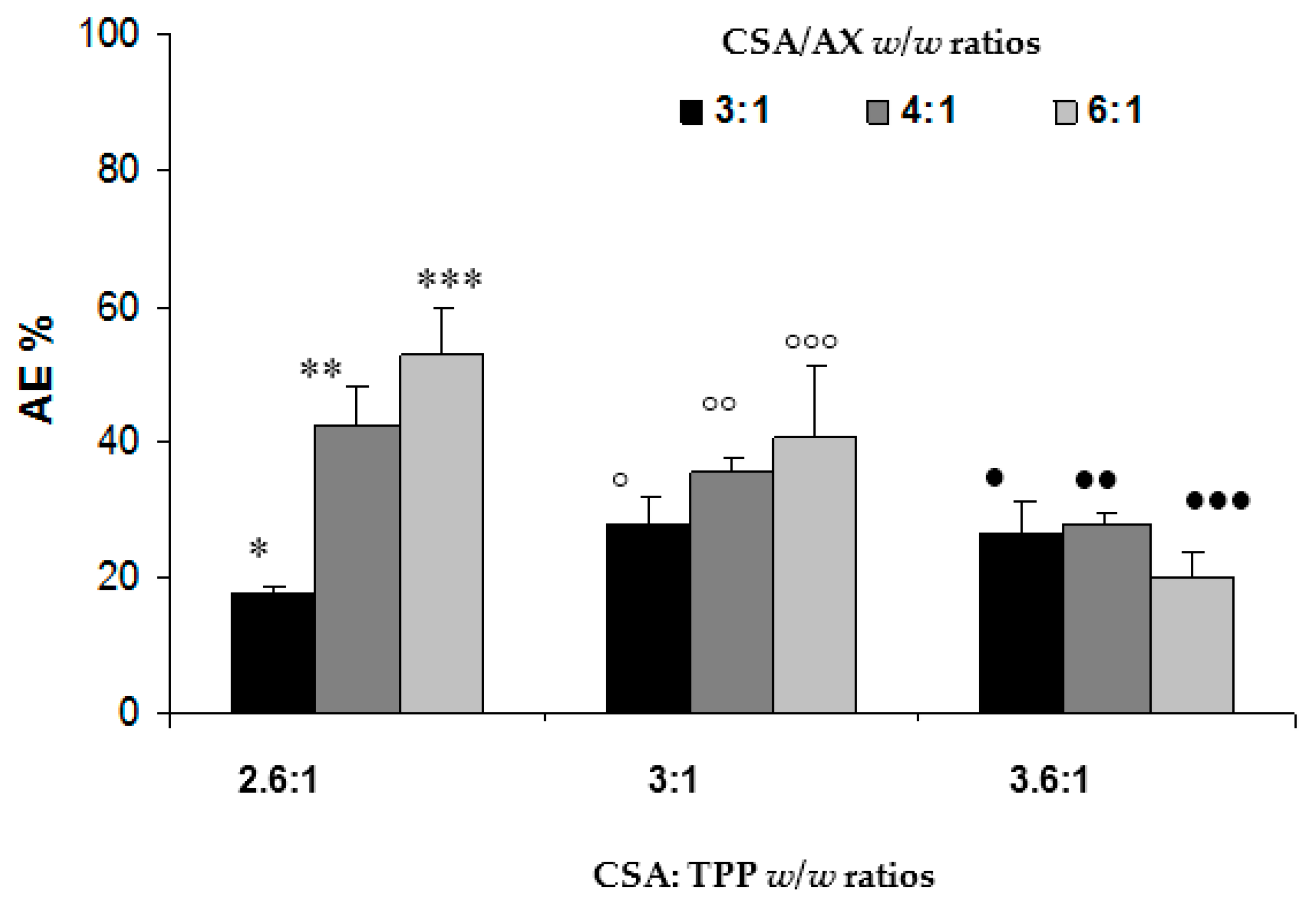
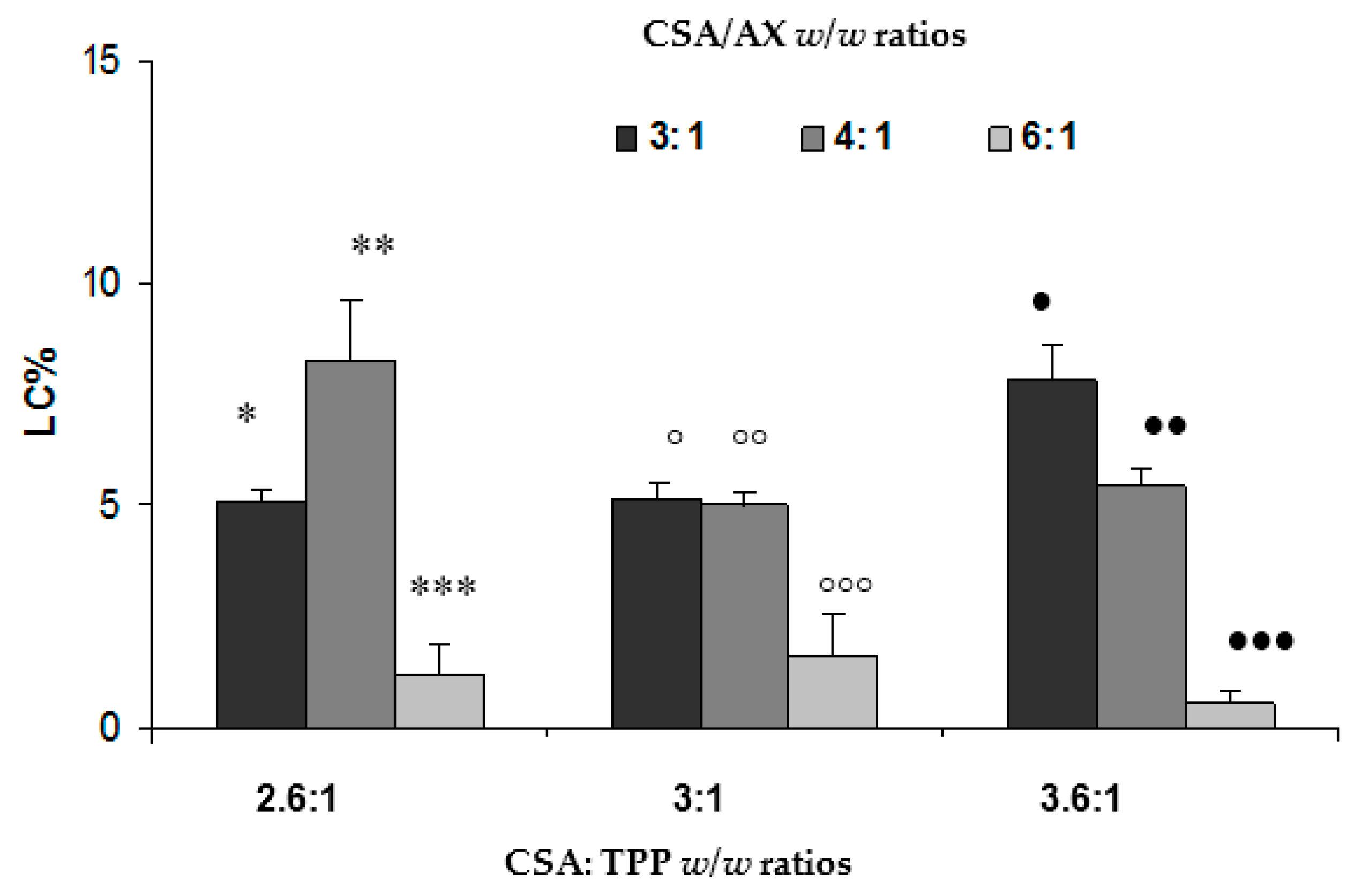
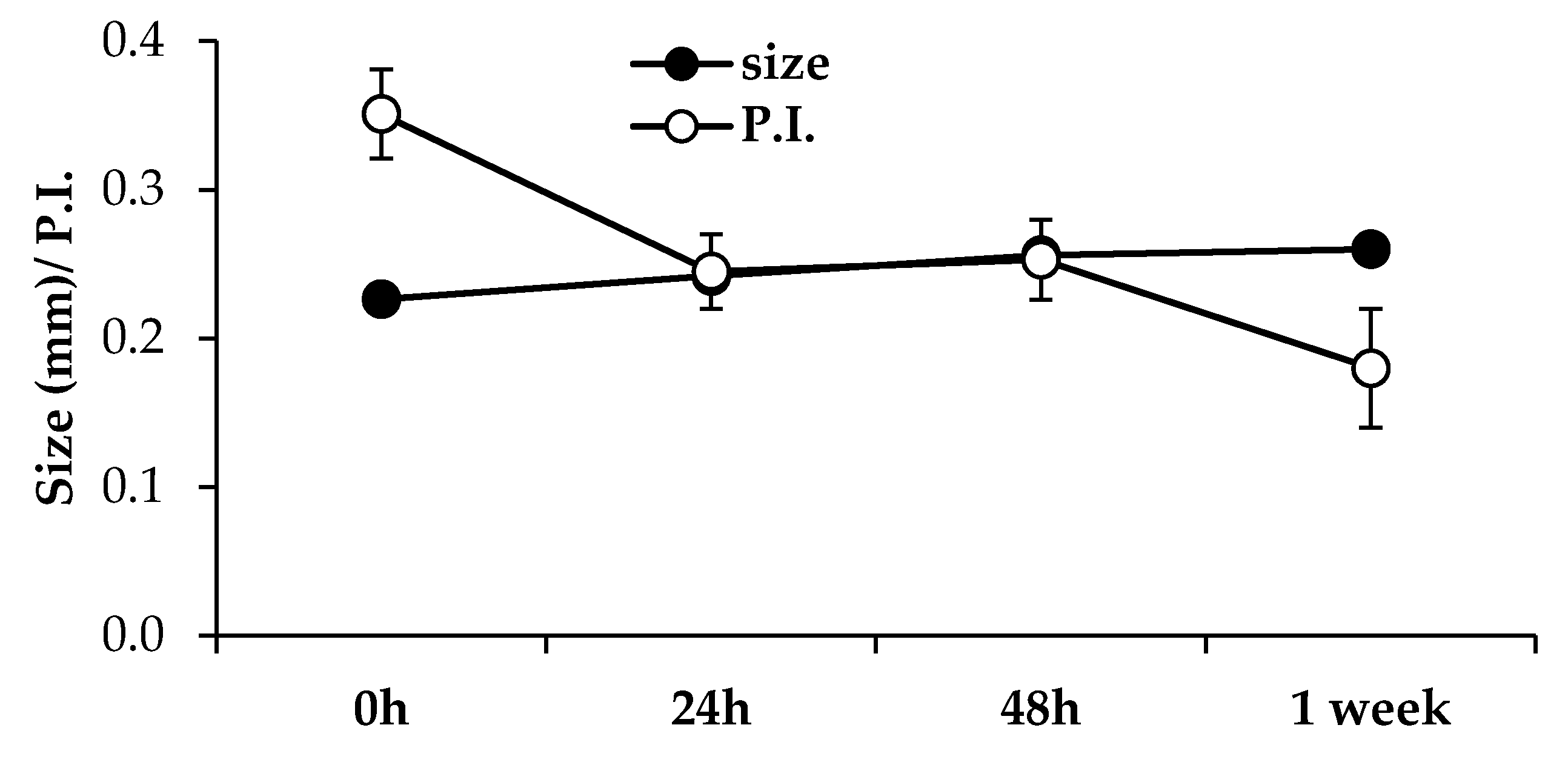
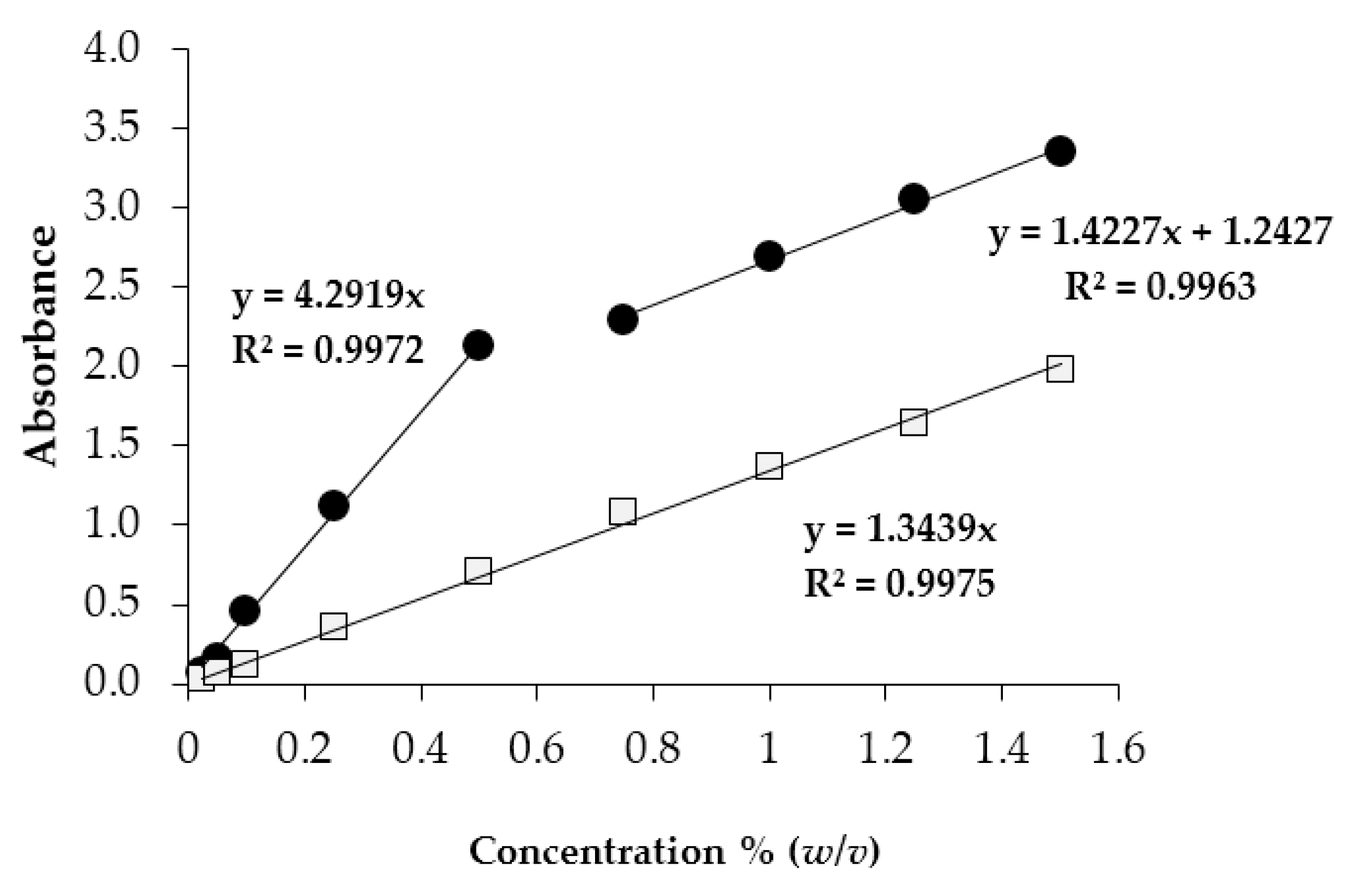
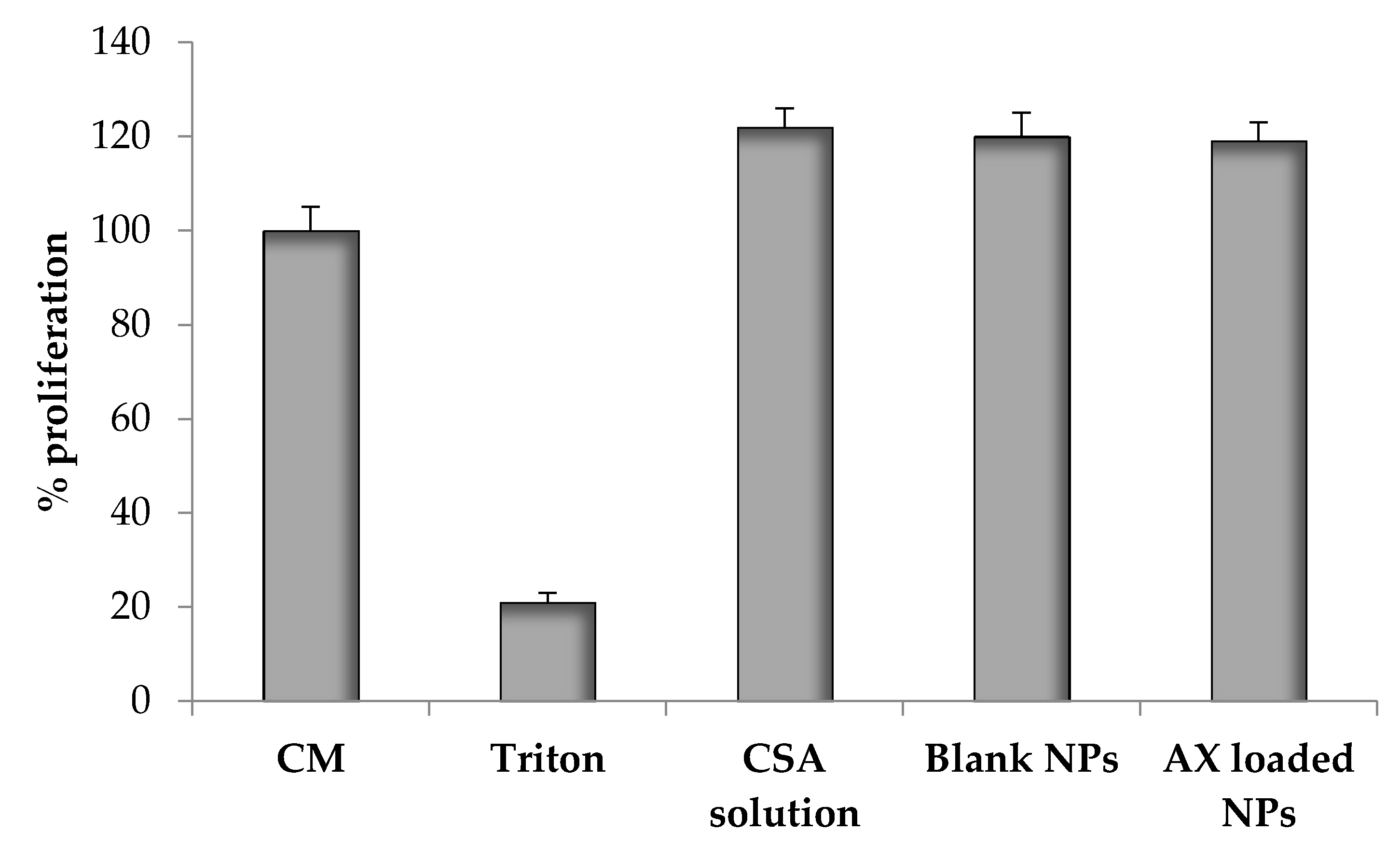
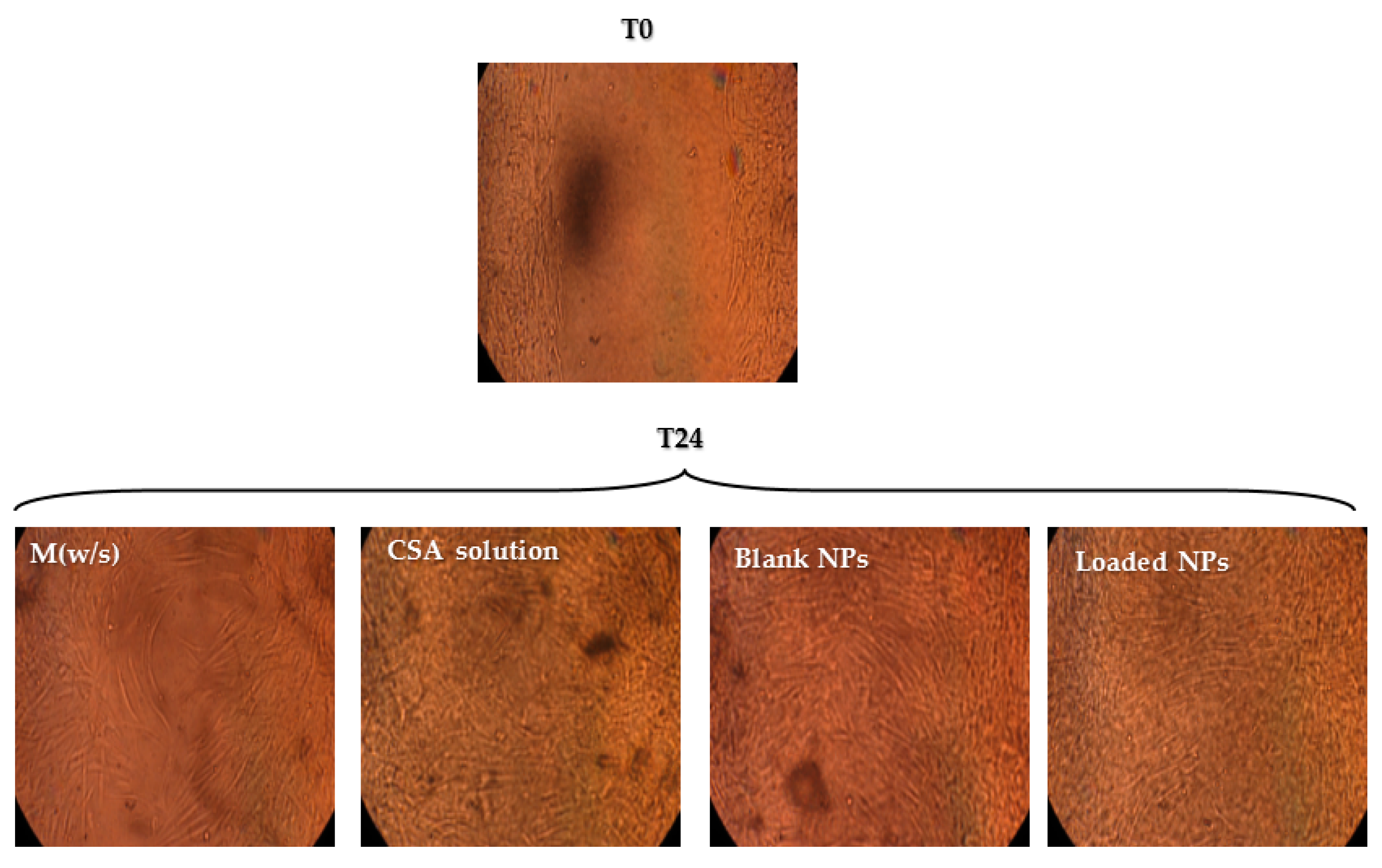
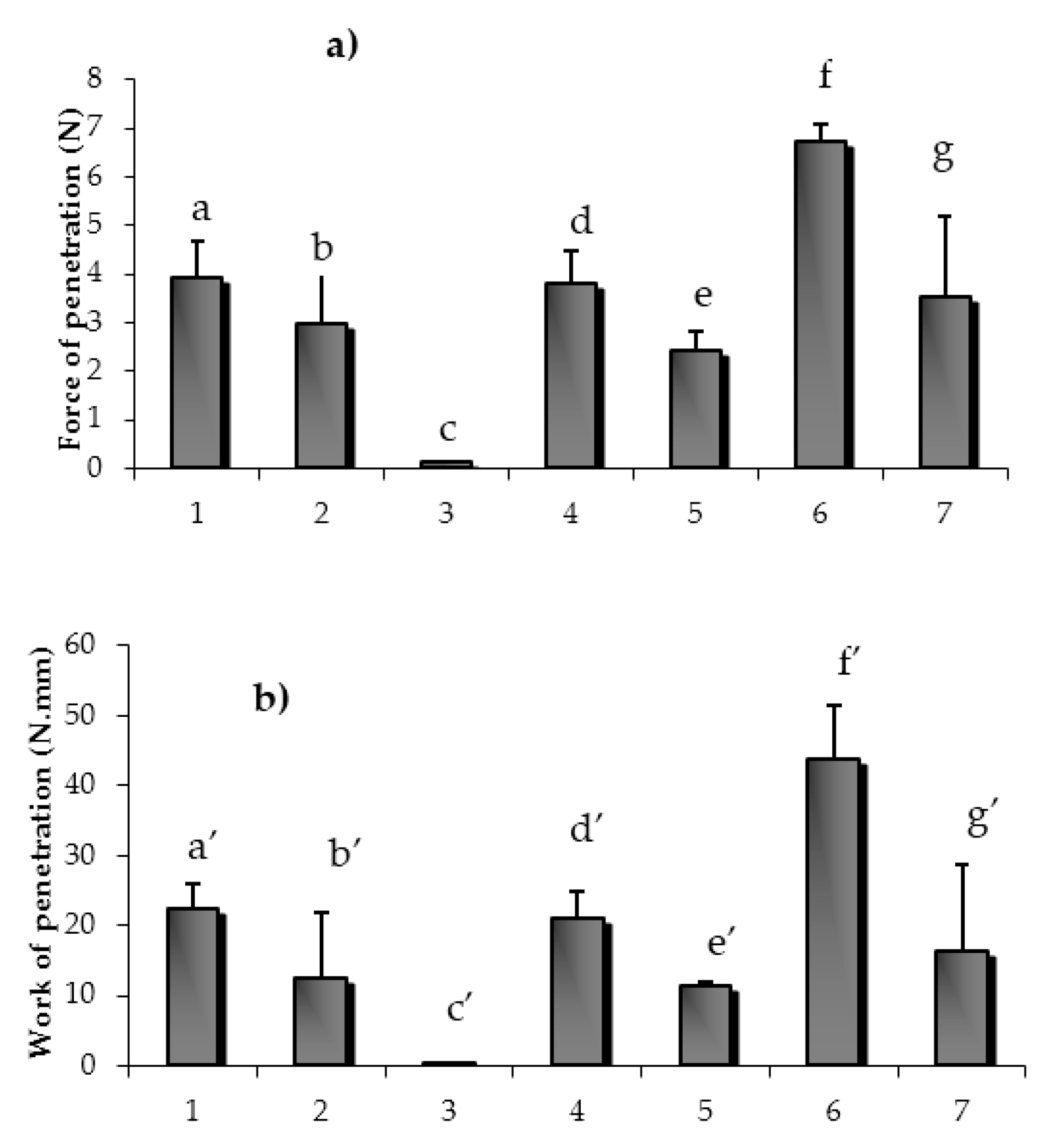

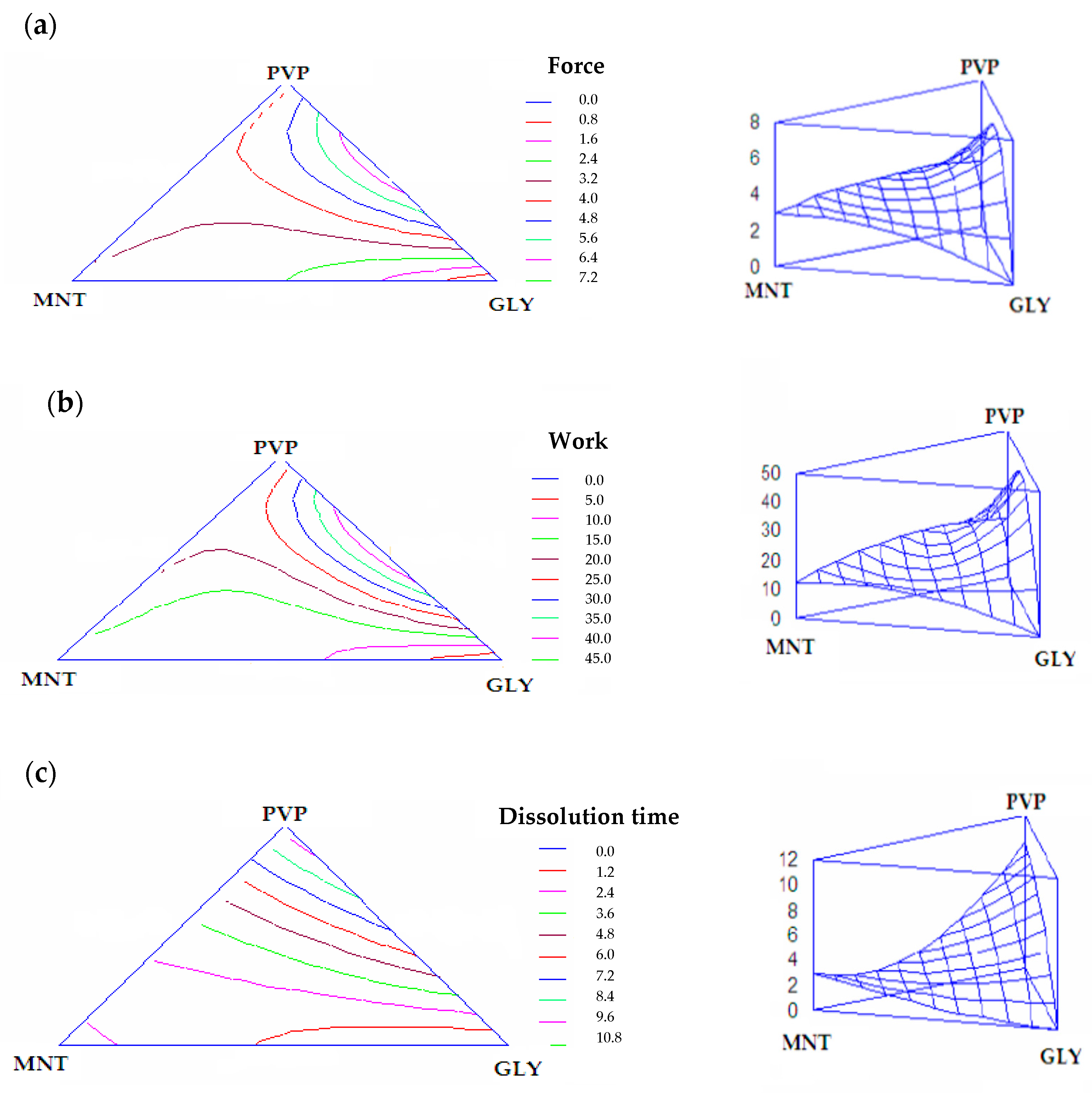

| CSA/TPP w/w Ratio | Size (nm) | P.I. | Yield (%) |
|---|---|---|---|
| 2.6:1 | 215 ± 3 | 0.10 ± 0.02 | 30 ± 1 |
| 3:1 | 236 ± 6 | 0.22 ± 0.03 | 22 ± 0.9 |
| 3.6:1 | 258 ± 6 | 0.28 ± 0.02 | 12 ± 1 |
| CSA/TPP w/w Ratio | Size (nm) | P.I. | Yield (%) |
|---|---|---|---|
| CSA/AX 3:1 w/w ratio | |||
| 2.6:1 | 232 ± 3 | 0.403 ± 0.080 | 43 ± 0.3 |
| 3:1 | 210 ± 3 | 0.415 ± 0.010 | 63 ± 0.1 |
| 3.6:1 | 256 ± 1 | 0.567 ± 0.060 | 43 ± 0.3 |
| CSA/AX 4:1 w/w ratio | |||
| 2.6:1 | 226 ± 7 | 0.251 ± 0.030 | 68 ± 0.2 |
| 3:1 | 215 ± 1 | 0.266 ± 0.020 | 74 ± 0.7 |
| 3.6:1 | 268 ± 5 | 0.592 ± 0.040 | 55 ± 0.2 |
| CSA/AX 6:1 w/w ratio | |||
| 2.6:1 | 234 ± 6 | 0.461 ± 0.040 | 73 ± 0.2 |
| 3:1 | 216 ± 1 | 0.354 ± 0.004 | 83 ± 0.3 |
| 3.6:1 | 228 ± 4 | 0.615 ± 0.040 | 64 ± 0.4 |
| Microrganism | CSA Solution | Blank NPs | Loaded NPs |
|---|---|---|---|
| E. hirae | 0.12% | 0.03% | 0.004% |
| S. pyogenes | 0.06% | 0.015% | 0.0001% |
| NPs Suspended in Excipient Solution | NPs Upon Matrix Dissolution | |||
|---|---|---|---|---|
| % NPs Loaded into Matrix | Size (nm) | P.I. | Size (nm) | P.I. |
| 8 | 220 ± 8 | 0.51 ± 0.03 | - | - |
| 14 | 222 ± 7 | 0.44 ± 0.06 | 225 ± 5 | 0.58 ± 0.07 |
| 25 | 338 ± 25 | 1.4 ± 0.07 | - | - |
| 40 | - * | - * | - | - |
| Samples | X1 (PVP) | X2 (MNT) | X3 (GLY) |
|---|---|---|---|
| 1 | 1 | 0 | 0 |
| 2 | 0 | 1 | 0 |
| 3 | 0 | 0 | 1 |
| 4 | 1/2 | 1/2 | 0 |
| 5 | 1/2 | 0 | 1/2 |
| 6 | 0 | 1/2 | 1/2 |
| 7 | 1/3 | 1/3 | 1/3 |
© 2017 by the authors. Licensee MDPI, Basel, Switzerland. This article is an open access article distributed under the terms and conditions of the Creative Commons Attribution (CC BY) license (http://creativecommons.org/licenses/by/4.0/).
Share and Cite
Rossi, S.; Vigani, B.; Puccio, A.; Bonferoni, M.C.; Sandri, G.; Ferrari, F. Chitosan Ascorbate Nanoparticles for the Vaginal Delivery of Antibiotic Drugs in Atrophic Vaginitis. Mar. Drugs 2017, 15, 319. https://doi.org/10.3390/md15100319
Rossi S, Vigani B, Puccio A, Bonferoni MC, Sandri G, Ferrari F. Chitosan Ascorbate Nanoparticles for the Vaginal Delivery of Antibiotic Drugs in Atrophic Vaginitis. Marine Drugs. 2017; 15(10):319. https://doi.org/10.3390/md15100319
Chicago/Turabian StyleRossi, Silvia, Barbara Vigani, Antonella Puccio, Maria Cristina Bonferoni, Giuseppina Sandri, and Franca Ferrari. 2017. "Chitosan Ascorbate Nanoparticles for the Vaginal Delivery of Antibiotic Drugs in Atrophic Vaginitis" Marine Drugs 15, no. 10: 319. https://doi.org/10.3390/md15100319





